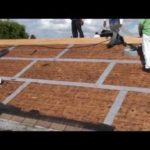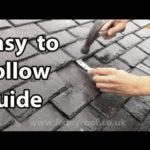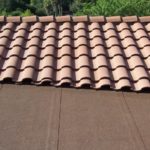Interested in design school? Want to know what it’s like / what to expect? Let me share my experience in Interior Design school with you, and help answer some …
Roof Repair- Termite and Dry Rot Damage

Removing termite damaged rafters and starter boards. I replace the damaged wood and prep for the new roof installation.
roof leak repair NJ
How to Clean Different Types of Flooring in Your Home
Confused about which cleaning method is best for you floor? Some cleaning solutions can work wonders on one kind of floor and wreak havoc on another. We thought we’d make it that little bit easier. So whatever your floor type, check out our top tips on how to keep them ship-shape.
Carpets and Tiles
Regular vacuuming is essential for carpets, as it prevents loose dirt and grit from working into the carpet pile where it will damage the fibres. Upright vacuum cleaners are best, especially those with revolving brushes to dislodge embedded dirt. Use the suction head for loop-pile carpets, as beater brushes and heads can cause the carpet to bobble. Manufacturers recommend an annual steam clean. Clean according to wear. Whether you do it yourself or call in the professionals, high-traffic areas should be cleaned once every two years.
Natural remedy
Remove wine or grease stains from carpet by lightly sprinkling area with baking soda. Dab it up and add a little more if necessary. Leave on until the wine is absorbed, then vacuum up any residue left.
Natural Flooring
All good quality natural floorcoverings should have a substantial latex back to prevent dust and debris falling through and ensure easy maintenance by vacuuming. A cylinder-type vacuum cleaner without brushes is the best choice for natural floorings to avoid damaging the fibres.
Most high quality natural floorings are sold with a stain inhibitor that protects them from dirt and prolongs there life, so ask your supplier for details of cleaning products for natural fibres. These should be used on stains immediately – not once the stain has been absorbed. Mop up with a clean cloth or kitchen paper. Don’t use carpet mousse or shampoo as these can cause natural floorings to shrink.
Consider hiring a professional cleaning company if you want to give your flooring a thorough clean, but make sure they use a dry-cleaning system as opposed to a wet on. Ask your retailer to recommend a firm
Wooden Flooring
Sweep wooden floors regularly, or use a vacuum cleaner with a brush setting. Mop once a week or so with a well-wrung mop, using soapy cleaner specifically for use on wood. Don’t saturate the floor or allow water to stand on it as this can cause damage. Wet-clean waxed boards sparingly and wax polish them to improve the patina. Dirty wax build-up should be removed with white spirit and the boards re-waxed. Treat engineered boards with oil or lacquer reviver, applied with a soft cloth.
Natural remedies
Remove scuff marks from wooden floors by rubbing them gently with a pencil eraser.
Bring out the natural colour of your wood flooring by wiping the surface with lemon oil and a dry cloth. However, this only applies to natural and waxed flooring, not varnished floors.
Laminate flooring
Laminate should be swept or vacuumed regularly. Using a damp cloth is fine, but never soak the floor with water – they’re designed to be water resistant. Most spills on laminate can be removed with household cleaners but, if the stain is lipstick, ink or permanent marker, try acetone. Never use scouring pads to remove stains on laminate flooring, and remove any liquid stains from the floor as soon as possible.
How to clean tiles and stone flooring
Stone floors
Stone will often have been treated before it left the factory. If not, it will stain easily so it’s important to seal it with a proprietary sealant or, for terracotta and slate, use linseed oil. Once sealed, clean it with a mix of mild detergent and water. However, it will need re-sealing at regular intervals to keep it looking its best.
Immediately wipe away any acidic spills.
Reconstituted stone needs to be sealed with a stain inhibitor then impregnated with a top coat of water-based sealant. It’ll need re-sealing every two years. Ask your manufacturer or suppler for specific care advice and suitable products.
Ceramic tiles
Ceramic tiles can be cleaned with a mild detergent and water solution and do not require sealing. Damp-mop your ceramic tile with a standard, all-purpose cleaner. Dry the floor with a soft cloth to avoid streaks.
Never use harsh abrasive cleaners that might scratch the glaze.
Flagstone, limestone, slate
Damp-mop flagstone or slate floors using either clear water, an all-purpose cleaning solution in warm water, or water to which fabric softener has been added. Wring the mop until it doesn’t drip, and apply it to the floor in slow, even strokes. Ask the manufacturer for recommend the appropriate cleaning product.
Wipe up spills on unglazed floors immediately or they might cause a stain.
Remove stubborn marks with white spirit, but always do a spot test first.
Flexible flooring
Vinyls, linoleums and rubber are hard wearing and easy to care for. The amount of cleaning and maintenance depends both on your lifestyle and the colour of the floor. Vacuum or brush regularly to remove dust and grit that might lead to your floor being scratched, and follow with a weekly wipe with the cleaning agent recommended by your supplier.
Remove scuff marks by gently rubbing with a scouring pad – the sort you would use to clean non-stick cookware.
Clean the floor with mild detergent and water. Don’t use abrasive cleaners, which may leave a dull film on your floor. Be careful with spray polishes and other silicone-based products as they can make your floor very slippery, as can white spirit.
REPLACING SHINGLE ROOF step by step

Replacing shingle roof, how to place new roof, how to remove old roof, how to remove flashings, Allied Roofing and Sheet Metal, Inc have been in roof repair …
roofing contractors nj
3 BHK Interiors of Mr. Ramesh | Sobha City | Bangalore
A walk through of another Sobha City home designed by Bonito! #foyer- As we enter the home we can see a simple foyer with an eye-catching mirror replicating …
Slate Roof Repair – How to replace a slate & broken slates

See my website link below for more roofing help http://www.fixmyroof.co.uk/videos-and-guides/pitched-roof/repair-a-slate-roof/ This video shows not only how to …
roofing contractors nj
Karndean Vinyl Flooring – Quite Possibly a Perfect Floor
Karndean vinyl flooring is one of the most exciting new floorcovering options available in the market. Karndean creates vinyl planks and tiles that realistically simulate natural materials such as Wood, Stone, Slate, Ceramic and Marble. With recent breakthroughs in technology, these luxury vinyl planks and tiles look so amazingly real it will surprise you.
These floors are very different from sheet type vinyl. As the floor is installed piece by piece, it gives a handcrafted look just as hardwood or real tile floors would appear. Karndean also manufactures these tiles and planks with semi random patterns so there are no repeating patterns to cause the floor to look cheap or like standard vinyl resilient flooring. A unique feature of Karndean is the coloring of the floors. Slight changes are made to the vinyl coloring to give a slight random color difference. By doing this, the floors look like the real thing and there are no dye lot issues if you ever need to replace a plank or tile. There are six distinct reasons why Karndean luxury vinyl tiles and planks are considered by many to be the perfect floor.
1. Karndean vinyl floors are stain proof against pretty much everything except petroleum based spills. This includes everything from red wine to pet urine.
2. These vinyl tiles and planks are waterproof as well. If you have a leak in the kitchen or bathroom, the water will not damage the vinyl. This is a very distinct advantage over true hardwood flooring and laminate. If you have a leak under the dishwasher, and you have hardwood or laminate, you will have to replace part or all of the floor at a huge expense. With Karndean, the worst case is you may have to have the floor reinstalled.
3. This flooring is hypoallergenic as well as mold and mildew resistant.
4. Luxury vinyl planks and tiles are very hard to scratch compared to laminate and hardwood. If you have pets, you absolutely cannot install a better floor than luxury vinyl.
5. Karndean tiles are almost impossible to chip or break when compared to ceramic, slate, stone and marble tiles. If you drop something heavy on them it may cause a slight indentation. Of course if you have real tile, it will probably crack or chip and will have to be replaced.
6. Cleaning is a snap. Dust mopping regularly and an occasional damp mopping is all that is needed. There is never a need to reapply any finishes or buffing needed.
Now that you know why Karndean is so close to perfect, what are some of the styles that are offered? There are 6 different series offered from Karndean.
1. The Van Gogh lines has 22 variations of Wood planks. Almost every color and species imaginable are available.
2. Art Select vinyl from Karndean has 11 options to choose from between simulated Wood planks and Limestone modular tiles.
3. Da Vinci is one the more popular styles for luxury vinyl tile. With over 33 selections of tiles ranging from 16 inch to 12 inch in Ceramic, Slate and Sandstone you can find about anything you desire. Wood planks are also part of the Da Vinci series.
4. Knight tile has 33 choices of tiles and planks. Terra Cotta, Marble, Slate, Stone and Wood round out Knight tile.
5. Karndean’s Michelango line is a unique product line of tiles for a distinct décor. There are 12 products including Italian Mosaic, Spanish Pebble and even a Metallic tile.
6. Renoir is the last series of vinyl plank and tile flooring from Karndean. Renoir has 13 different types of Wood, Slate and Concrete tiles.
Roofing Tile Leak Repair – Tips, Tricks & Helpful Hints

In this relatively brief video I tackle an ‘S’ tile roofing leak repair & take you through the step by step process of fixing a roof leak the way that I consider to be the …
roofing repair NJ
Interior Design — How To Design A Two-Storey Family Room
Designers Rachel Keach and Diane Ernjakovic of One Three Design share a bright main floor they designed for a young family. See how they used architectural …
Laminate Flooring How To – Covering Concrete Stairs With Laminate
You have a beautiful laminate floor and you’re wondering if you should finish the concrete stairs in laminate to give the space a cohesive, designer feel. First of all, is it possible? Can you cover concrete with laminate? The answer is yes. In fact, if you’ve ever covered wooden stairs, the process is similar, except that the nosing installation is a little trickier.
What You’ll Need
To accomplish this task you’ll need:
- PL200 or stronger construction glue
- Skill saw for cutting laminate
- Chop saw for cutting metal nosings
- drill with a concrete bit
- electric screwdriver
- plastic plugs
- broom
I recommend using metal nosings as these are stronger, and will hold better on concrete stairs. (Laminate nosings that come in a kit are also trickier as the tracks need to be in exactly the right spot, and there isn’t a lot of standardization–every manufacturer makes a slightly different size/style of laminate nosing).
What to Do
Start by sweeping the stairs and cleaning up any shavings or dust. You’ll need a clean surface for the glue to adhere properly to the concrete and laminate. Once the area is clean, start with the risers first.
Measure, mark and cut each laminate plank to fit the riser with the groove side facing downwards. Glue the riser and the back of the plank, and secure the plank in place, again, making sure that the groove is at the bottom of the riser. Once all the risers are glued, you’re ready to start on the nosings.
Begin by measuring and cutting the metal nosings to fit. Mark on the concrete where the screws will go, then using a drill with a concrete bit, drill the holes. Place a plastic plug in each hole. Number the nosings so that you match each one to the correct tread when you screwnail them in later.
Measure, mark and cut each laminate plank to fit the tread with the groove side facing inwards to meet the bottom of the riser. Arranging the planks so that the groove on the riser meets the groove on the tread makes for a clean, professional edge in the corner. Glue the tread and the back of the plank and secure the plank in place, making sure that groove faces inward.
Stair nosings are intended to finish the look by capping the lip of the stair. Unfortunately, with concrete stairs this can be a little tricky as the lip on the stairs is often thicker than the actual stair nosing. If this is the, cut a laminate plank so that it’s wide enough to cover the the concrete lip, and glue it to the face of the lip on each tread. Then secure the nosing over top by screwnailing it through the laminate tread into the pre-drilled holes in the concrete. (If you’ve already covered the lip-face with laminate, you can glue the nosing to the laminate for extra adherence, and then screwnail the top of the nosing into place.)


